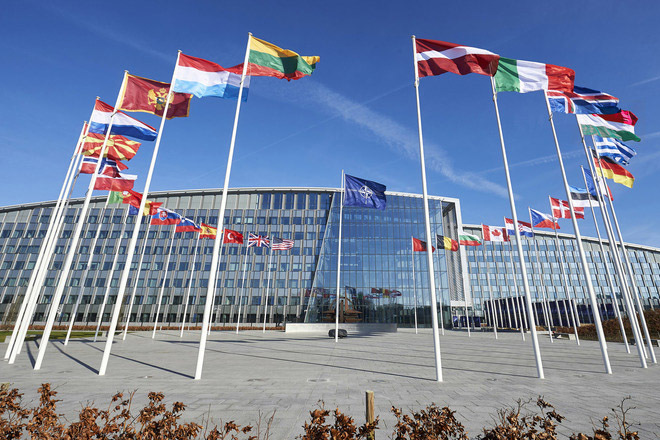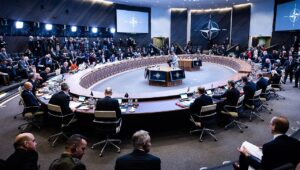Workshop
The workshops aimed to bolster an exchange among PoC leaders working in, on, or with NATO. The format encouraged sharing expertise, presenting new research findings, and identifying a greater understanding of progress and future challenges in implementing PoC at NATO. In particular, the workshops focused on future conflict contexts. The discussion also looked at what NATO should consider while developing its next Strategic Concept, #NATO2030 planning, and a new PoC action plan. The meetings successfully identified areas for future research and analysis and areas of progress and gaps in the implementation of PoC across NATO. Further, the conference fostered a network of policymakers, military officers, practitioners, and experts interested in seeing PoC effectively implemented. The following findings and recommendations are drawn from the four days of workshops and reflect the expert exchange.
Key Takeaways
Since the PoC policy’s adoption in mid-2016, NATO has built a structural framework for PoC and moved toward practical implementation of the policy’s ambition to better mitigate harm to civilians, both from the impact of NATO operations and harm caused by other belligerents. That policy aims to protect civilians in all operations across four areas:
- Understanding the human environment
- Mitigating harm
- Facilitating access to basic needs, and
- Contributing to a safe and secure environment.
Today, an informal collaboration between various NATO bodies, included the Human Security Unit under the Office of the Secretary General; ACO; ACT, and non-governmental organizations has made progress. Indeed, the PoC Action Plan itself noted the importance of this collaboration as one of the 17 lines of work necessary to support implementation.
Stimson designed the first annual workshop series to build a more formal network among a diverse group of PoC practitioners. Key takeaways from the conference span NATO’s structure — from high-level political concerns to military and security force capabilities, form planning to ally and partner concerns. They include:
Implementation to Date:
- Participants found that NATO has made much progress on PoC. They felt that more work is necessary, however, to support the implementation of PoC across NATO and realize the aspiration outlined in the policy. For example, the North Atlantic Council (NAC) adopted the first action plan, which initially ran from March 2017 through March 2019. It is unclear if the NAC will support developing a new action plan or additional work on PoC, both of which are needed.
- PoC at NATO enjoyed strong support and attention in the run-up to the 2016 Summit and adoption of the policy and action plan. Today, that effort needs a renewal given the full agenda and competition for time and thought by other issues. For NATO to fulfill its policy ambitions, it should prioritize PoC in its current and future strategies and mandates.
- For PoC to become an integrated, core element of future NATO operations, as envisioned in the PoC policy, NATO allies and partners need to signal political will in support of implementation including by establishing dedicated human and financial resources.
- While NATO has made much progress in understanding how to protect civilians from its own actions (civilian harm mitigation), it should develop a greater understanding and clarity in protecting civilians from the harm committed by other belligerents.
- While the PoC Policy rightly looked to address future NATO operational requirements, the policy is treated more as a moral aspiration, or “nice to have,” rather than a mission-critical capability. This approach needs to be reconsidered if the protection of civilians is to be understood as a strategic imperative for NATO and likely a core objective for future missions, including for those conducted within the borders of NATO allies and partners.
- PoC already exists, in a military context, in NATO doctrine and in that of some partners and allies. Several allies and partners contributed their PoC guidance during NATO’s development of the policy and concept. Yet, there is no full cataloging of existing national and state policy and practice. Understanding where POC inputs already exist can change the perception that PoC is a new concept in conventional security or just a humanitarian concern based primarily on the UN-context of peacekeeping.
Why PoC Fits with NATO’s Future
- Workshop participants saw 2021 as a year of opportunities for NATO stakeholders to prioritize the implementation of PoC by NATO and with allies and partners. This year marks the fifth anniversary of the policy. The current diplomatic environment (including the revitalization of transatlantic relations under the Biden administration), the new Strategic Concept, the next NATO Summit, and the work of the #NATO2030 initiative are all opportunities for a renewed commitment to progress on PoC implementation.
- As a values-based alliance rooted in the rule of law, NATO should be a leader in the evolution of norms relating to the protection of civilians and conflict. NATO’s values should drive the conversation and bolster its allies and partners. Participants noted that both political and military leaders should see PoC as a core value of NATO and a critical strategic capability. NATO’s credibility, as well as the credibility of allied and partnered armed forces, helps build trust and foster resilience among people they are supposed to protect, as well as the resilience of NATO itself.
- To foster success in future missions, NATO needs a shared understanding of PoC inculcated in all NATO political and military leaders and through political-military coordination and cooperation. Several attendees mentioned that there does not seem to be a clear understanding on the political side as to what is happening on the operational side and perhaps vice versa on PoC. Bridging that political-military divide is key to ensuring that PoC objectives in future operations — from creating a political mandate to mission execution — are clear and actionable.
Additional Challenges:
- POC may be innately challenging for a security organization such as NATO as it requires both military and civilian roles — much like a ‘whole of government’ approach. On the one hand, NATO’s focus on security requires expertise in assessing threats to civilians as part of operational planning, a skill that participants thought needed further development. At the same time, NATO structure/resource constraints have not yet employed a deep bench of political and diplomatic experts on PoC in the offices of NATO Permanent Representatives or Headquarters who can consider these issues. Further, civilian expertise on PoC issues is limited to the international staff. In contrast, when the UN deploys, the military mission works closely with a robust civilian component to plan for and ensure a mission-wide strategy to protect civilians. This is not yet the case at NATO — at least in current and past missions. Participants noted that military planners struggled to “understand the human environment,” for example, one critical capability in PoC. NATO must think through how to address these challenges, including drawing upon lessons learned from past conflicts where critical capabilities such as Civilian Casualty Tracking facilitated the mission’s ability to understand its impact on the civilian population.
- If PoC is to be a core capability of NATO and its allies and partners, resources and staffing should be allocated for HQ. Within the Human Security Unit, the team only has one national contribution staff member focused on PoC, despite having policy responsibility. Participants found an imbalance between the PoC Policy’s ambition and the resources, staffing, and political support backing it.
- Workshop experts pointed out that PoC is not just a means to an end (as it is seen in counterinsurgency) but also an end in itself. The future conflict/crisis contexts in which NATO may find itself engaged will require knowledge, skills, and capabilities in PoC, including protecting its own citizens. Notably, in a collective defense/in-area Article 5 scenario, PoC is a strategic imperative because civilian populations are always a target of influence.
PoC in the Future:
- Violence against civilians is unlikely to decline in future warfare and is often purposeful. Given trends in conflicts, which include an increase in proxy wars, non-state actors, violations of international humanitarian law, and direct attacks on civilians, participants noted the importance of recognizing that future operations will need to consider that conflict often extends into or even begins in civilian areas. Additional challenges, such as cyber warfare and disinformation campaigns, are also aimed at civilian populations and are part of NATO’s thinking for 2030.
- Workshop members emphasized that NATO’s understanding of PoC needs to better capture the idea that protection is not always about restraint. To protect civilians from others’ harm, a proactive stance is needed. The discussion noted that NATO should maintain strict adherence to international humanitarian law and build added capabilities for protection, such as civilian harm mitigation tactics, techniques, and procedures as essential tools for protection. NATO should also broaden its approach, skills, and knowledge to embrace preventing harm to civilians from the acts of others. Harming civilians may be part of an enemy’s strategy to defeating NATO forces
- Consideration of the Ukraine example illustrated how and why PoC is important in collective defense/Article 5 scenarios. During a discussion of Ukraine, participants noted that it was as an example of how a NATO partner/ally can use PoC policy and supporting documents to influence policy discussions on the national level. Ukraine is creating a national PoC policy, has plans to institutionalize PoC training within the Ukrainian military education system, and wants to create a PoC Center of Excellence — all spurred on by NATO’s adoption of the PoC Policy.
- Public statements from NATO senior political leaders are critical to garner greater stakeholder buy-in and attention on PoC in ally and partner countries. Numerous participants noted the importance of validating and supporting the PoC policy and approach.
Recommendations
Throughout the workshops, participants offered ideas and recommendations to address challenges and strengthen NATO’s successful implementation of its policy on protecting civilians for future missions. These include:
- Design a more precise PoC roadmap. Support for PoC from allies should be encouraged to build support as well as demand for PoC implementation. There is interest in and demand for information about PoC within the offices of some Permanent Representatives.
- Develop and adopt a new Action Plan spanning 3–5 years. This Action Plan should begin in 2021 to continue implementing the PoC Policy, focusing on strengthening operational and tactical capabilities in future NATO missions.
- Include a robust discussion of the importance of PoC to future mission sets in the forthcoming Strategic Concept. Some interlocutors noted that there were few PoC discussions at NATO today, but that PoC should be seen as a critical part of future priorities.
- Rebuild and sustain political attention on PoC. One way to do this is for interested allies and partners to opt into an affinity group such as the “Friends of PoC.” This process has worked well in many settings, where member states work together to achieve recognition and progress on a policy priority (e.g., Group of Friends of PoC) and provides a loose but helpful structure for allies to establish discussions, move work forward, and revitalize other allies and partners’ interest support in political efforts.
- Establish and resource a small but efficient Center of Excellence on PoC. Ideally, this would serve as a home for future thinking and research on implementation and would provide an excellent opportunity for NATO allies and partners to work together to move PoC forward jointly.
- Strengthen the formal PoC lessons-learned process to ensure that lessons of the last three decades are effectively captured and applied to future mission sets. This process may benefit most from a collaborative effort with those outside of NATO to ensure a comprehensive view.
- Emphasize PoC across all military directorates, including intelligence, operations, planning, communications, and civilian-military cooperation. Almost all military functions can and should play a role in effective PoC. PoC considerations should be integrated into all planning stages and processes, whether Article 5, crisis response, or security force assistance and training.
- Make PoC an Operations Directorate issue to demonstrate that it is a core activity rather than specialized. For example, the military does not currently see perpetrators of civilian harm as opponents/adversaries, and therefore they are not “tracked” by J2. They need to be designated as opponents to get the visibility required to identify threats from other actors.
- Integrate PoC into SHAPE’s Comprehensive Crisis and Operations Management Centre (CCOMC). The CCOMC is tasked with “thinking, planning and acting strategically and comprehensively in multiple crises and operations simultaneously. It provides an understanding of the full breadth of the crisis spectrum; identifying crises and assessing their impact on the security of the Alliance and other crises; and strategically directing ongoing NATO operations to deliver comprehensive outcomes of collective benefit to the Alliance, its partners, and nations in need of assistance.” PoC will be an essential component in future NATO missions across the crisis spectrum. Throughout the conference and our research, we heard that PoC is often considered “mostly a function of the J9.” Integrating the PoC concept and lenses into the work of the CCOMC provides a meaningful way to ensure PoC consideration across the spectrum in all future operations.
- Tailor operations to specific threats/perpetrators, including developing protocols to conduct better threat assessments. Participants urged that analyzing how and why perpetrators hurt civilians is often missing from plans. To do this successfully requires cooperation across the J2, 3, 5, and 9. There is a need for more systematic data collection on violence against civilians, regardless of who is responsible. NATO should share data with a broader community of researchers to allow for collaborative analysis and lessons learned.
- Require systematic and specialized training on PoC for all military staff involved in NATO operations as part of mandatory training across the various J roles. This training should, notably, include the threats-based approach. While the week-long NATO PoC training developed and deployed by FINCENT is a fantastic starting point, more specialized operational and tactical training is needed.
- Build an expert PoC bench to deploy alongside military components. To support the implementation of PoC policy in future operations, some urged that it would be useful to have a specified civilian PoC advisor with deep experience working with military and humanitarian counterparts.
- Undertake a benchmark PoC state-of-play study to document how allies and partners have adopted and implemented the various PoC policy tenants into their national policy, practice, and training — and where gaps remain. It is imperative to understand what individual allies and partners already have in their national policies and practices to chart the path for future work — both for NATO and their allies and partners. The work think tanks and universities such as Leiden University with the German government have done to understand the current state of play within their national policy, practice, and training could be a model for other nations. Just as NATO policy and practice can contribute to national implementation, the reverse is also true.
- Develop and secure support for a biennial report on “Ally and Partner Progress on Implementing PoC.” There is precedent for this in other areas such as women, peace, and security, and gender. Allies and partners should commit to a self-report on PoC progress in policy, doctrine, guidance, and training every two years. For example, they could use the national reports model to the NATO committee on gender perspectives and pick 10 specific PoC effectiveness indicators.
About this Report
We welcome comments and inquiries on this workshop or the Strengthening NATO’s Ability to Protect. Stimson colleagues Marla Keenan (Non-resident Fellow and project lead), Katie Dock (Research Assistant), Victoria Holt (Vice President and project lead), and Alex Hopkins (Research Associate) compiled notes and wrote this report. We would like to thank workshop attendees for their time, insights, and contribution to the discussion, including the excellent presenters and discussants. We would also like to thank our partners at PAX and the Dutch Ministry of Foreign Affairs for their generous support of this work.
We hope that this short readout is useful for both participants and those interested in the topic and NATO’s future. This first annual workshop was incredibly fruitful in broadening the understanding of current and future challenges in PoC. The discussion actively identified opportunities for future research, projects, and collaboration.
If you would like to be part of future discussions and workshops, please contact Marla Keenan or another member of the team listed above.




